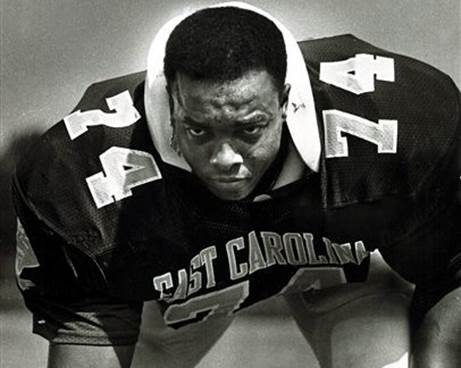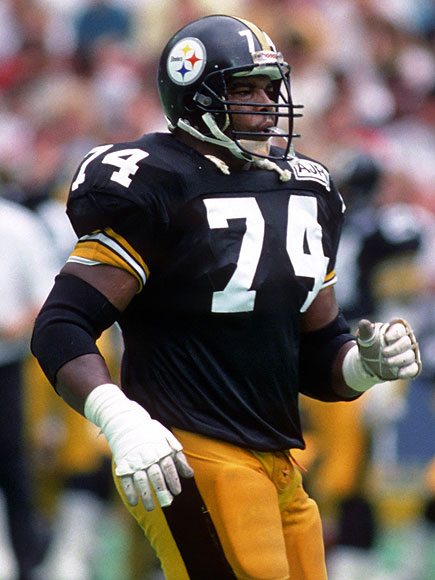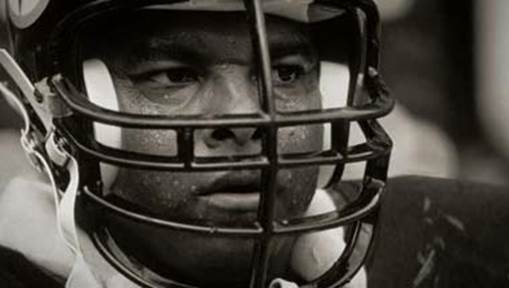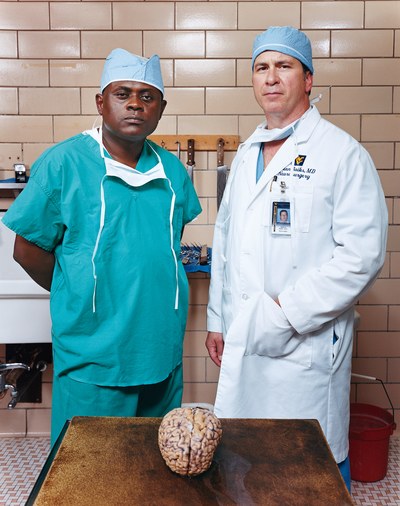

TERRY LONG; WHAT'S GOOD, WHAT'S BAD, WHAT'S UGLY
HELMET HUT NEWS/REFLECTIONS July 1 2016:
TERRY LONG; WHAT'S GOOD, WHAT'S BAD, WHAT'S UGLY
By Dr. Ken
WHAT’S GOOD:
At Euclaine High School in
Columbia, South Carolina, a
young Terry Long was going
nowhere fast on the football
field. Entering his senior
season the 5’11”, 160 pound Long
had few physical attributes to
lend to the squad and no
on-field experience, so instead
returned to a variety of after
school jobs to help support his
widowed mother and six other
siblings halfway through the
season. This truncated season of
varsity football was the
high-water mark of the athletic
career of Long when he left high
school. He joined the United
States Army as so many other
high school graduates do, was
assigned to the 82nd
Airborne and spent two years in
the Special Forces. Three months
into his new life he found the
weight room and dedicated any
leisure time to this new
obsession. Despite logging more
than sixty jumps and running
four to five miles daily, Long
grew a lot of muscle. Akin to
something out of the Charles
Atlas ads, the relatively thin
and definitely under-muscled
Long responded spectacularly to
the physical demands of Army
life and his new weight training
pursuit. By the conclusion of
his hitch, he was no taller but
he had put on almost one hundred
pounds of what appeared to be
solid muscle, played noseguard
on the Fort Bragg football team
that competed in an
intra-service league, and most
impressively, could now squat
with 500 pounds, bench press
405, and deadlift 400. His
forty-yard sprint time was
clocked at 4.8 seconds, he could
perform a standing flip at any
time, and dunk a basketball from
a standing start. He had
survived the rigorous “torture
training” where because of his
size, Terry was usually the
“prisoner” who was punched and
kicked when captured by mock
enemy forces during base
maneuvers and he thrived on it.
In short, Terry Long had
transformed himself from Clark
Kent to Superman!
Now eager to play more
football and pursue an
advanced education, Long
contacted a number of
university football programs
and received scholarship
offers from Nebraska and
Wyoming among others, but
preferred to remain close to
home and family, choosing to
attend East Carolina
University. While the
coaching staff, like
everyone else was impressed
with Long’s physical
development, he had little
in the way of football
technique and knowledge and
later admitted that he had
“spent the first two years
at ECU learning how to play
football.” He did however,
work hard and he learned.
Under the guidance of
legendary Strength And
Conditioning Coach Dr. Mike
Gentry who later established
himself as one of the best
in the profession during his
twenty-nine seasons at
Virginia Tech, Long also
succeeded in becoming
perhaps the strongest
college football player of
all time. Listed at 279
going into his junior season
of 1982, he had improved by
leaps and bounds, touted as
a potential All American on
a very talented squad that
included running back
Earnest Byner. ECU’s 1983
team was often referred to
locally as “The Unknowns” as
few out of the area or
school alumni knew that
twelve players from that
squad would be drafted into
the NFL and two others would
ply their wares in the
Canadian Football League.
Knowing that they had an
unusual physical
specimen in their midst,
the Pirates public
relations department
went full blast to
garner recognition for
the team and
specifically for Terry
Long. Posters peppered
the Carolinas, featuring
Long in swim trunks and
a muscular pose with the
admonition to “Come See
the Strongest Man In
College Football When He
Comes To Your Town,”
harking back to the
circus and carnival
posters of old. Strength
Coach Gentry, himself a
successful powerlifting
competitor, convinced
Terry to enter the North
Carolina State
Powerlifting
Championships where
under official
competition conditions,
Long proved himself the
equal of the top lifters
in the world. His
twenty-one inch neck and
twenty-two inch arms
helped him elevate 837
pounds in the squat, 501
in the bench press, and
865 in the deadlift,
only thirty-nine pounds
less than the existing
world record! With a 441
hang clean and training
lifts of 900 squat, 565
bench press, and 865
pound deadlift and the
addition of a
thirty-four-inch
vertical jump at a body
weight close to 300
pounds, there was no
doubt that this physical
education major was up
to the rigors of pro
football. That he became
East Carolina’s initial
AP Consensus First Team
All American proved that
he also had mastered the
physical skills
necessary to rise to the
next level of the sport.
Pro Scouts had told him
had he been three or
four inches taller, he
would have been a first
round draft choice but
instead was taken as the
Steelers second pick in
the fourth round of the
1984 draft. By ’85 he
was a starting guard,
well liked for his easy
going personality, and
donated a scholarship to
East Carolina
University. Long had
overcome a background
fraught with problems
and obstacles to become
a professional football
player, proving that
there was still a place
for unrelenting hard
work and perseverance in
one’s quest to fulfill a
dream.
WHAT’S BAD:
Although the medical
information was already
beginning to come in
about the deleterious
effects of anabolic
steroids, there is no
doubt that the early to
mid-1980s was the zenith
of their use by
professional football
players. It took the
sporting world’s
reaction to Canadian
sprinter Ben Johnson’s
breathtaking
performances at the 1987
World Championships and
1988 Olympic Games and
subsequent
disqualification for
steroid use to bring the
matter to the forefront
of public attention but
there were signs years
before that this was
coming. Another Canadian
sprint athlete, Mike
Dwyer “expressed concern
that the use of drugs
had reached ‘epidemic
proportions’ among
Canadian sprinters” in
1986. Obviously, it is
impossible to procure or
know accurate figures
but those who worked
closely with NFL, CFL,
and USFL players have
placed rather high
estimates on steroid use
among offensive and
defensive linemen. Many
either during that time
period and especially
prior to the NFL’s ban
on and testing for these
performance enhancing
drugs in 1987 admitted
that they used them and
often lamented that “I
have to, if everyone
else is on something. I
have to be able to
compete.”
The
birth of the United
States Football League
no doubt led to a larger
than expected
proportional increase in
anabolic drug use,
unexpected at least, to
the typical fan who
lacks the insight to a
football player’s
emotional drive. Those
who worked in the drug
testing field were
perhaps surprised at
first to find that the
largest numbers of drug
use failures were
recorded for the
smaller, or lower level
collegiate programs when
the NCAA began testing
for drugs. Needless to
state, the players
recruited to Michigan,
Ohio State, Texas,
Alabama, Pittsburgh,
USC, and the other major
powers were the best or
certainly among the best
in the nation. Their
ability, existing size
and strength, and
football instincts
allowed them this
advantage and thus, they
most often did not seek
out the edge offered by
anabolic steroids. Hall
of Famer Anthony Munoz
summed it up well by
stating that he never
used enhancement drugs
because he just didn’t
need them and “felt
sorry for those who
believed they did.” The
Division II player who
was an inch or so too
short, a step or so too
slow, or otherwise not
quite up to the
recruitment standards of
the Big Ten, SEC, or SWC
were more likely to seek
out “something to make
up for their lack of
whatever it was” in
order to realize their
dream of All American
status or a pro football
contract. Despite the
presence of many
exceptional players in
the USFL, the majority
met the criteria for
those “just lacking in
NFL qualities” and in
the professional game,
estimates were made that
drug use was higher
there than in the NFL
itself. In either case,
it was not unusual
relative to the behavior
of a large percentage of
professional football
linemen of the early
1980s to indulge in
anabolic or other
performance enhancement
drug use. Speculation is
just that,
“speculative,” but in
Terry Long’s case, it is
fact that he failed an
NFL drug test indicating
the use of banned
anabolic steroids at the
start of the Steelers
training camp on July
11, 1991. When notified
of the results, Long
attempted suicide and
was admitted to the
psychiatric ward of
Allegheny General
Hospital, either by
“taking some sleeping
pills” or by the more
publicized and reported
ingestion of rat poison.
The truth was worse;
Long had locked himself
in his garage with the
car engine running and
only the quick response
of his current
girlfriend who dragged
him away from the carbon
monoxide saved him. The
next day he ate rat
poison and was
hospitalized.
In what became legendary
head coach Chuck Noll’s
final season, Long did
in fact lose his
starting guard position
to Carlton Haselrig,
starting but three of
the eight games he
played in until the NFL
announced his four game
suspension on November
15th. Thus
ended the eight year
professional football
career of Terry Long;
shamed by the public
revelation of his
anabolic drug use, an
unsuccessful suicide
attempt, and reports by
his teammates of unusual
behavior.
THE UGLY:
Even before the
announcement of his
positive steroid test,
teammates noted a change
in Terry Long’s
behavior. His sudden
mood swings and bouts of
depression were a
contrast to the gracious
“T-Bone” so well liked
by everyone. Already
divorced, he shed
himself of the
girlfriend who had saved
him from his first
suicide attempt,
remarried, and
vacillated between
loving husband and
enraged adversary. He
gave a great deal of
money away to those who
asked and had a
succession of failed
businesses, in part
because he could not
maintain his focus on
any one project for a
sustained period of
time, in part because he
would not leave his home
for days at a time. His
former teammates had, in
his final season, often
referred to Terry as
“Sybil” because of the
many personalities he
flashed in the locker
room. Some in-the-know
attributed his change in
behavior to steroid use,
others were bewildered
but there was no doubt
that Terry Long was no
longer the Terry Long
whom Noll himself was so
fond of. After
retirement, life rapidly
spun out of control. By
March 23, 2005, an
indictment had been
issued, charging Long
with a litany of fraud
related crimes and most
seriously, the arson
that had destroyed his
Pittsburgh based Value
Added Foods chicken
processing plant on
September 23, 2003.
These very significant
charges that carried a
maximum of fifty-five
years in prison and
$2,000,000.00 in fines
augmented an outstanding
Missouri warrant for
passing bad checks in
the Kansas City area.
Pathologist Bennet Omalu
and neurosurgeon Julian
Bails examined two
Steelers brains, Long
and Mike Webster, that
began what can be called
“The CTE Movement”
In an era that now seems so long
ago, the time-honored way to
discipline and perhaps
“straighten out” a college
football player who fought too
much, may have been too casual
about class attendance, or was
otherwise a “behavior problem
but a good kid” was to convince
them to join the military for
what used to be the available
one or two year stints, and then
return to school. In most cases,
for those who did return to the
college campus and football
program, the military service
had the desired effect . The
older, more experienced,
worldly, and disciplined
individual was usually able to
contribute to the football team
and campus community in a
positive manner. For others like
Terry Long, voluntary military
service provided the time and
opportunity to become, as the
slogan goes, “all he could be”
and rise to the level of an
effective National Football
League player and starter.




Long “appeared
disheveled during his
(court) appearance” and
could claim only the
$300.00 in his pocket
and a checking account
holding $750.00. His
home was in foreclosure
and he was again facing
divorce proceedings.
Once more he attempted
suicide, drinking a can
of Drano, survived the
ordeal and revisited the
psychiatric ward. On
June 7, 2005, his
attempts to take his own
life were finally
successful, succumbing
to the organ and brain
damage inflicted by
drinking a can of
anti-freeze. As a
suicide, the autopsy was
left to the Office of
the Medical Examiner and
Long, like his teammate
Mike Webster, became the
foundation for the early
studies into what became
christened, Chronic
Traumatic Encephalopathy
or CTE. Chronicled in
books and on film, the
war of words, financing,
ultimate responsibility,
and associated lawsuits,
the many battles of CTE
had former East Carolina
University great and
Pittsburgh Steelers
starting right guard
Terry Long firmly
planted on the ground
floor. To this day, no
one can state with
certainty what belied or
what propelled the
demise of Terry Long,
yet, “what was good” in
his dedication to
literally will his way
onto the gridiron
through his focused hard
work should be
remembered long after
“what was bad” and “what
was ugly.”